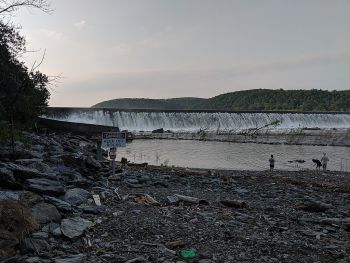Concrete/Masonry Dams: Difference between revisions
From ASDSO Dam Safety Toolbox
No edit summary |
No edit summary |
||
| Line 10: | Line 10: | ||
|caption= | |caption= | ||
<!-- Add picture caption --> | <!-- Add picture caption --> | ||
Photograph of Holtwood Dam, a concrete | Photograph of Holtwood Dam, a concrete gravity dam located along the Susquehanna River in south central Pennsylvania. ([https://en.wikipedia.org/wiki/Holtwood_Dam Wikipedia]) | ||
}} | }} | ||
Revision as of 23:28, 23 November 2022

|
| Photograph of Holtwood Dam, a concrete gravity dam located along the Susquehanna River in south central Pennsylvania. (Wikipedia) |
Concrete and masonry dams are constructed as either gravity dams, buttress dams, or arch dams depending on how they maintain structural stability. Concrete dams can be constructed using either conventional concrete or roller-compacted concrete (RCC). Masonry dams are constructed using stone, brick, or other masonry units joined together using mortar. Construction of masonry dams is labor-intensive and is less common in modern dam construction than other types of dams.
Types of Concrete/Masonry Dams
Best Practices Resources
![]() Pocket Safety Guide for Dams and Impoundments (Federal Emergency Management Agency)
Pocket Safety Guide for Dams and Impoundments (Federal Emergency Management Agency)
![]() Federal Guidelines for Dam Safety: Glossary of Terms (Federal Emergency Management Agency)
Federal Guidelines for Dam Safety: Glossary of Terms (Federal Emergency Management Agency)
Citations:
<references />
Revision ID: 4604
Revision Date: 11/23/2022
